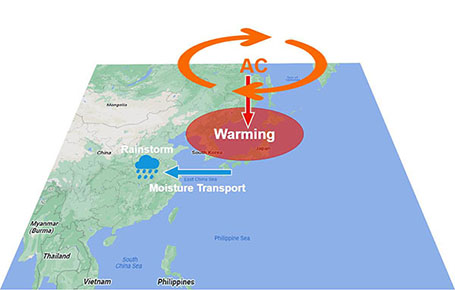reveals the unprecedented nature of an anticyclonic anomaly that occurred over Northeast Asia in July 2021. It not only played a pivotal role in the catastrophic extreme precipitation experienced in Henan province in central China but also caused a prolonged and intense marine heatwave in the Japan Sea—the strongest event of its kind in the western North Pacific in the past four decades. The marine heatwave triggered an unprecedented widespread outbreak of harmful algae in the coastal waters, causing serious damage to the marine ecosystems and a record-breaking loss to Japanese coastal fisheries.
The corresponding author of the study, Prof. LU Riyu from the Institute of Atmospheric Physics (IAP) at the Chinese Academy of Sciences, emphasizes the magnitude and duration of this anomalous anticyclone, stating, "The anomalous anticyclone event over Northeast Asia in July 2021 was unprecedented in terms of intensity and duration. It remained extremely persistent and robust for an astonishing 10 consecutive days from July 13 to July 22, 2021."
The impact of the persistent heavy rainfall was widespread, affecting 150 counties and a staggering 147.86 million people, leading to direct economic losses amounting to 1200.6 billion yuan. On July 20, Zhengzhou, the capital city of Henan province, witnessed a tragic toll, with a total of 380 casualties.
Previous studies have revealed that the unprecedented event was the result of the combined effect of multiple weather systems. Prof. LU's team investigates the evolution of the extreme anomalous anticyclone event over Northeast Asia in July 2021, and further explores the significant impact of this anomalous anticyclone on surface temperatures beneath it. The study reveals that the anomalous anticyclone led to exceptionally warm sea surface temperatures in the Sea of Japan/East Sea, persisting for an extended period of 30 consecutive days from July 13 to August 11, 2021—well after the weakening or departure of the anticyclone.
The extreme anticyclonic anomaly over Northeast Asia triggered multiple climate disasters over distinct regions in July 2021. (Image by IAP)
Further analysis in the study suggests that two key factors contributed to the longevity of this anomalous anticyclone: a teleconnection pattern over extratropical Eurasia during the first half of its life cycle and the Pacific-Japan teleconnection pattern during the latter half.
This study underscores the critical role of extremely anomalous anticyclones at mid-high latitudes in triggering multiple climate disasters over distinct regions. Understanding and monitoring such anomalies are essential for enhancing our ability to predict and mitigate the impact of extreme weather events.
Citation: Zhou, X. Y., and R. Y. Lu, 2024: The unprecedented extreme anticyclonic anomaly over Northeast Asia in July 2021 and its climatic impacts. Adv. Atmos. Sci., https://doi.org/10.1007/s00376-023-3026-5.

